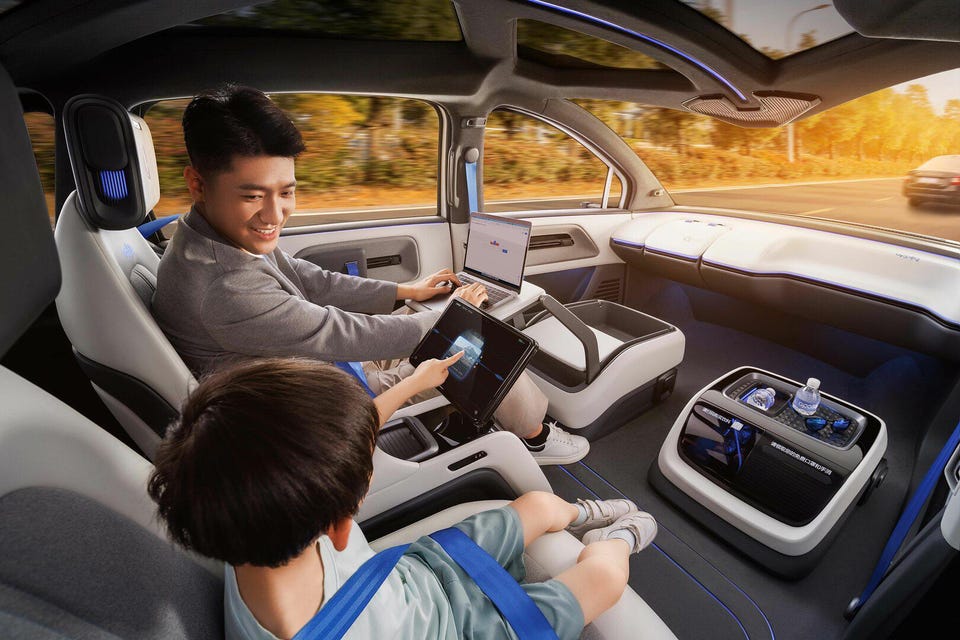Transportation Baidu Unveils Custom Robotaxi With Steering Wheel That Will Be Removed Brad Templeton Senior Contributor Opinions expressed by Forbes Contributors are their own. I cover robocar technology & previously worked on Google’s car team. New! Follow this author to improve your content experience.
Got it! Jul 20, 2022, 10:00pm EDT | New! Click on the conversation bubble to join the conversation Got it! Share to Facebook Share to Twitter Share to Linkedin Baidu robotaxi after steering wheel is removed, configured with desk and drink dispenser in front Baidu Baidu BIDU , the Chinese search giant, has revealed a new custom designed robotaxi it states will go into service in their Apollo Go autonomous ride-hail service starting in 2023. Baidu states the vehicle costs around $37,000 to make and will allow them to scale-up their service to tens of thousands of units over time. A strange feature of the design is that the initial vehicle includes a steering wheel which will never be used in normal operation.
Instead, it is designed to be removed, and will be once Chinese law permits vehicles with no steering wheel. The result will be a more open cabin. Unlike the “Robezium” (trapezium or toaster) shape of custom vehicles from Zoox and Cruise, the Baidu Apollo RT6 has a similar shape to other custom taxis, designed around a comfortable and spacious back seat area.
Renderings show one of the front seats replaceable with a refrigerator or laptop table, though passengers can eventually sit up there, not cramped by the steering wheel. There is some similarity to the shape planned by Waymo for their custom robotaxi made by Zeekr, a unit of the Chinese automaker Geely. The vehicle also includes things you expect in EVs, like a flat floor, independent seating, and screens for digital interaction.
The sensor suite is integrated into the roofline and electric sliding doors are included. (Waymo, which began its robotaxi service with Pacifica minivans, decided not to have automatic sliding doors, though those are available in minivans. ) Unlike the Zoox and Cruise Origin, which have face-to-face seating and seem designed more for “shared ride” service with strangers, this design seems more taxi oriented, with all seats facing forward, though that could easily change.
Many look forward to face to face seating for families and other larger groups to allow social interaction, though some passengers are less comfortable facing backwards. MORE FOR YOU Tesla Challenger Polestar Powers Up With Nasdaq Listing Plan Valuing It At $20 Billion Driver Killed By His Own Car Door While Waiting In Line At Fast-Food Drive-Thru, Providing Cautionary Insights For AI Self-Driving Cars Tesla Cofounder’s Recycling Startup Plans To Become EV Battery Material Powerhouse Zoox has now certified its own vehicle for operation in California, and has manufactured about a dozen. Its new Fremont factory is geared to make tens of thousands, according to Zoox.
A price of $37,000 is lower than the estimated costs for most other vehicles, like Waymo’s Jaguar i-Paces, particularly when sensors are included. As a cost of production, it is naturally lower than the retail price of consumer vehicles. Once you clear out all the non-recurring costs of a robotaxi service (which heavily dominate the budget today) depreciation will become a large part of the per-mile cost of a robotaxi.
As such, lower vehicle costs will mean lower fares as there are no driver costs. (There are costs for remote operations centers, cleaning, recharging, maintenance, depots, accidents, map maintenance and other factors to consider, of course. ) Outside view of Baidu robotaxi, fairly minivan-like.
Baidu has not revealed their manufacturing . . .
[+] partner. Baidu Baidu has been operating robotaxi service in 10 major Chinese cities, and on the outskirts of Beijing, 25 units operate with a Baidu employee in the passenger seat rather than at the wheel. At Baidu World 2022, along with the announcement of the RT6 vehicle, Baidu also announced that they had done one million robotaxi orders, which is a large number, though there are no audited figures for any service.
Baidu has also started charging fares for these rides. While charging fares does not show any particular technical achievement, it’s a worthwhile step on the path to figuring out the right business models for a service. At present, most services are charging fares in a manner similar to taxis or Uber UBER style services.
All early robocar developers worked by modifying existing cars, with some, like Waymo, doing special manufacturing partnerships with Chrysler and Jaguar to make their modifications. Others, like Zoox, were founded on the idea that a robotaxi should be a custom design, redone from the ground up. Tesla TSLA plans to get into robotaxis, and initially announced it would use off-lease Teslas with minor modifications (allowing them to get somebody else to eat up almost half the depreciation on the vehicle.
) Later, Tesla teased they were also working on a custom robotaxi design. This Baidu design sits in the middle, with a custom interior, but a fairly traditional vehicle body and door configuration. It’s great to see a lot of ideas and plans compete for the future.
Read/leave comments here Follow me on Twitter or LinkedIn . Check out my website . Brad Templeton Editorial Standards Print Reprints & Permissions.
From: forbes
URL: https://www.forbes.com/sites/bradtempleton/2022/07/20/baidu-unveils-custom-robotaxi-with-steering-wheel-that-will-be-removed/
